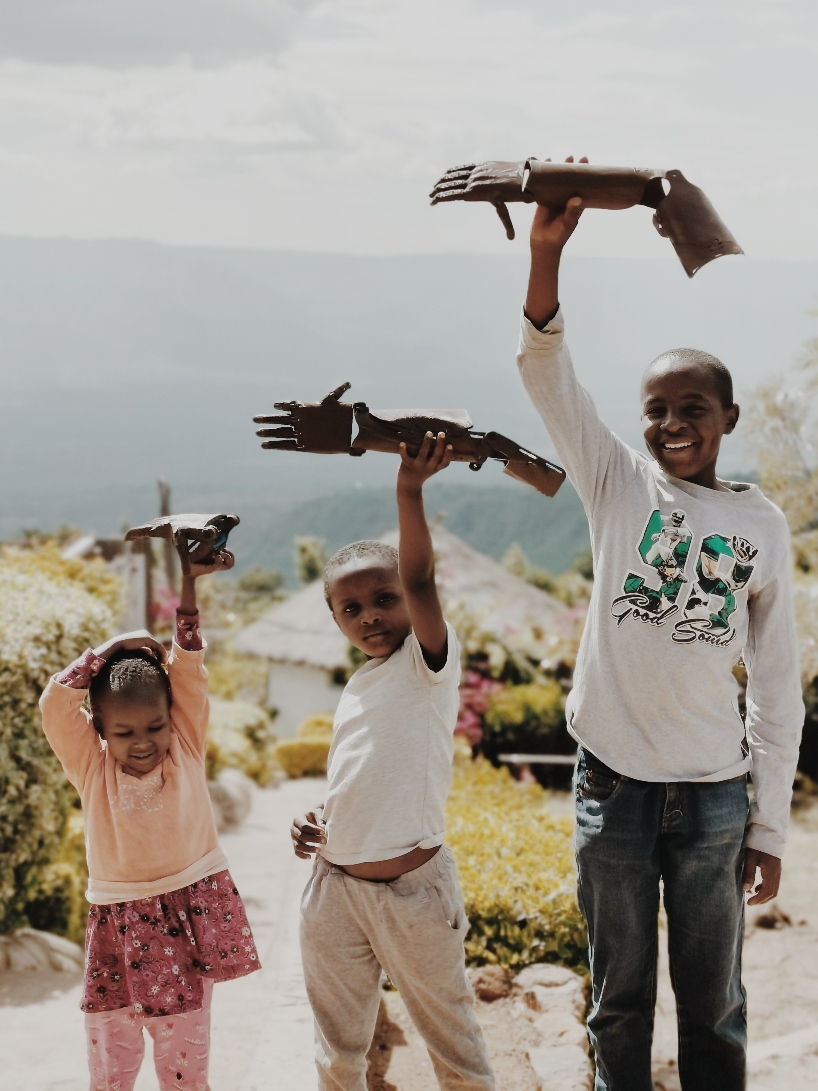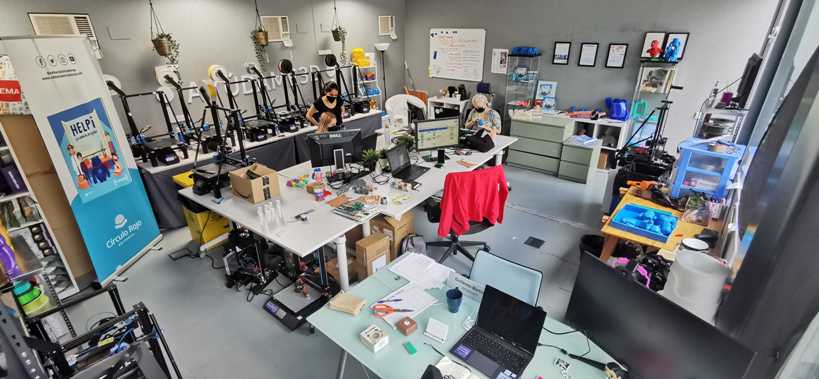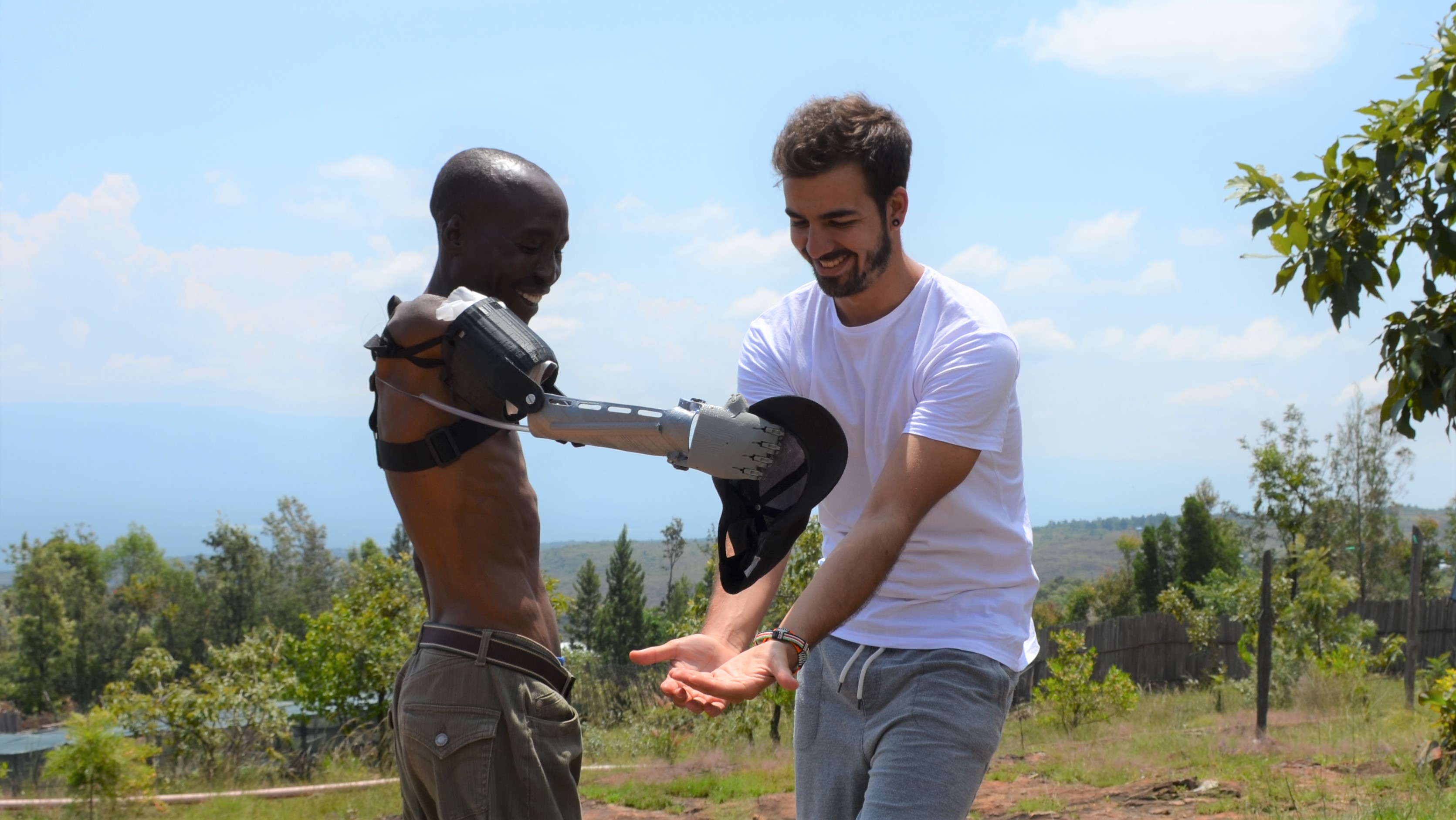Guillermo Martínez is the Founder of Ayúdame3D, a Spanish organization, that promotes social equity through 3D Printing. They create "Trésdesis" which are 3D Printed Prosthetic arms that Ayúdam3D gives to people in need for free.
How did Guillermo get involved with 3D Printing? -- To Make His Own Toys
It was 2016 and I bought a 3D printer as a Christmas gift. I started printing Pokemon, toys, and home decorations... Then I found some arm designs on internet and I printed them. Suddenly, I had some arms printed and didn't know what to do with them. I was going on a trip to Kenya and got the idea to ask there if someone would want a 3D printed prosthetic arm. The coordinators from the orphanage found 5 people but they needed something that didn't exist until the moment. A 3D arm that works for people with no elbow. A full arm. I had time so I started designing and trying a new prototype creating the first 3D printed arm for people with no elbow.
Please describe the different prosthetics you offer and how they were designed.
The 3D printed arms are made by materials that are accessible and easy to find and change. We want our 3D-arms to be functional and easy to use. We also use biocompatible material for the parts of the arms that are in touch with the skin. In the beginning, thanks to collective knowledge and designs from Enabling The Future, we started using some models that were already online and ready to use. In 2017, we created the first 3D printed arm for people with no elbow. We are always designing and developing new products so right now we use our own designs.

Please describe some of the most inspiring / heartwarming moments you have
experienced providing prosthetics.
One of the first people that got a 3D printed arm by Ayúdame3D was Philip, a teacher from Rift Valley. He told me that he had been asking for help for years, even to the authorities and the government and that it was impossible to get any attention. It was so emotional because he told me “as a teacher I will finally be able to grab a book in one hand and a pencil in the other”. Those words were everything I needed to know. I couldn’t stop there.
Did you play a lot of toys/games growing up? Do you still play any?
I have always been so passionate about toys: their mechanism and how they work. I mean, when I was five I was always trying to guess how the washing machine worked for example. I was fascinated by everything that had a mechanism. I was always inventing my own toys and trying to create new products and designs. That’s why when I grew older I knew it was only fair that I become a toy maker. My first “real job” was in a toy company as a product designer. I’m so happy that now I found what I really love: combine my passion about designing and making products with the possibility of helping other people. Also, I’m a huge Digimon fan so I got an impressive collection of them and I must confess even though they are on display at my room, I sometimes like to play with them again.
What were/are your favorite toys and games?
Any toy that meant I had to build something or create something. For me, it’s amazing when a toy can become something else or has different forms on it. As I said, I also love collection figures from my favourite tv shows or films like Digimon, Star Wars, Pokemon, Marvel...
What advice do you have for toy/game designers and students?
My advice would be to remember how you felt as a child, how emotional it was to receive your favourite toys. I think it’s also important to keep in mind that kids nowadays aren’t the same as we were, they have different tastes and necessities. Checking how it’s the market, trying to innovate and search for new products that might be disruptive and always focusing on what kids want is fundamental to succeed. Also, if you have an idea that already exists or is developed by somebody else, it’s always positive to create synergies.
What advice do you have for someone with a big idea?
Always believe in your idea but be cautious because there’s a chance not everything will work out. I don’t want to sound pessimist but I personally don’t like the idea of “if you believe it, everything is fine”. There are a lot of circumstances out of your control that are important to keep in mind. Hard work, people you believe in and that believe in you and focusing on what you really want are the keys for me. I’m aware that I had an idea in which I trust and it worked out pretty well for me but I’m lucky for that. Be realistic and work hard.
How can everyday people make a change and an impact on the world?
By looking around and thinking about how they can make anything better for their neighbours, friends or family. Helping each other is so important in a world full of contradictions and inequality.
Do you see an intersection between toys/games/play and the work you do?
Of course! I bought my first 3D printer because my dream was to be able to make my own toys. My passion for toys and its world has helped me become who I am today, professionally speaking. That’s why I created Helpi, Ayudame3D’s mascot. Helpi is a toy for kids (and adults) but also a solidarity product that helps us continue helping.
Where did you grow up and how did that influence who you are today?
I grew up in Aluche, a working class neighborhood in Madrid. From a very young age I was able to realize that there’s a lot of diversity and that not everybody has the same opportunities in life and that’s not fair. Knowing the real world since I was little has helped me to be more aware and conscious. That’s why it is so important for me to work towards creating a better and more fair and equal world.
What is the most rewarding part of your job?
Knowing that what I do from my little office space with my team and our volunteers makes a direct impact in people's lives. Not everyone gets to say that their job is literally changing lives and making them better.

What's next? What are the future plans for Ayúdame3D and any upcoming projects in new areas?
We are looking forward to creating more 3D labs around the world to continue empowering territories through technology and helping more people each day. Also, we are constantly investigating, developing and creating new help devices that can make people’s lives easier. Our main goal is to help as many people as we can and to make society aware of the importance of using our resources for social benefits.
Since you don't charge for prosthetics how do you support your organization?
Where can people donate? Who can they reach out to for a partnership?
We offer companies and schools different programs which focus on spreading the social value of technology and our philosophy that helping is too easy not to do. This is our main activity right now, working towards changing the world by creating a more conscious society. We have our corporate social technology responsibility program for companies in which we give the employees a motivational talk and develop together a team-building activity or a social program. We also have helping which is an educational method in which we teach 3D Printing to kids but always putting the focus on social aspects. This means our program teaches kids how to 3D print with a social purpose. All profits within these programs are destined to continue manufacturing and creating help devices. On the other hand, we also have the traditional NGO model which means people can donate, become a member or buy solidarity products at our website. All the info is posted at ayudame3d.org
How can people get involved with your organization or to support the cause as a whole if they're interested?
By following us on social media @ayudame3d and sharing our content so more people are aware of the importance of social technology and helping each other. Also, they can become members from 3 euros/month or get any of our solidarity products at our website www.ayudame3d.org.
Related Product
Recent Blogs
Recent Blogs

General
McHALE DESIGN CASE STUDY: MONSTERVERSE- THE LEGEND CONTINUES…

General
Build-A-Bear Celebrates National Teddy Bear Day with Donation to The Toy Foundation™

Industry Commentary, Op-Ed
Toy Foundation Auction is Now Open for Your Bids

Industry Commentary, Op-Ed
Bracelets, Stickers, and Viral Fame: The Story Behind Sky Castle Toys’ Sticki Rolls

Biographies and Interviews
Chrissy Fagerholt: Luck is when Preparation Meets Opportunity!
See more
Recent Wiki

BOOK REVIEWS
Book Review: Storm: Dawn of a Goddess by Tiffany D. Jackson

BOOK REVIEWS
Book Review: Erno Rubik and his Magic Cube by Kerry Aradhya

BOOK REVIEWS
Game Review: Trip Chaser

COMPANIES
Learning Express Toys Hosts 25th Annual Convention & Toy Expo at JW Marriott Tucson

MISCELLANEOUS
Submit Your LA Showroom Details for 2025 Toy Previews
See more
POP's Got Talent

POP Entertainment
Randy Klimpert Shares his Ukulele Collection

POP Entertainment
Steve Casino Peanut Art

POP Entertainment
Everyone's Talking about POP!

POP Entertainment
Princess Etch - a Multi-Talented Etch A Sketch Artist

POP Entertainment
Joseph Herscher of Joseph' s Machines.
See more
Recent POPcast

Hidden Role: The Brains Behind your Favorite Games
Connie Vogelmann designed Apiary & Wyrmspan!

Hidden Role: The Brains Behind your Favorite Games
Bob Fuhrer... Is THE Crocodile Dentist!

Hidden Role: The Brains Behind your Favorite Games
Tom Dusenberry... Bought Atari, Wizards of the Coast, and Avalon Hill!

Hidden Role: The Brains Behind your Favorite Games
Matt Leacock created Pandemic... the game!

Hidden Role: The Brains Behind your Favorite Games
Scott Brown and Tim Swindle... are Launching a New Sport!
See more
POPDuos

POPDuos: Interviews with Legends and Leaders
POPDuo: Richard Dickson, Mattel’s President & COO, and Kedar Narayan, Young Inventor Challenge AMB

POPDuos: Interviews with Legends and Leaders
POPDuo: Will Shortz and Josh Wardle

POPDuos: Legends and Leaders Explore Creativity
POP Duo: Elan Lee, Co-Founder, Exploding Kittens.and Jeff Probst, Host and Exec Producer, Survivor

POPDuos: Legends and Leaders Explore Creativity
POP Duo: David Fuhrer, MNG Director, Blue Sq Innovations & Shawn Green, past Dodgers & Mets MLB Star

POPDuos: Legends and Leaders Explore Creativity
POP Duo: Bob Fuhrer, Founder, Nextoy and Tom Fazio, Golf Course Designer
See more















